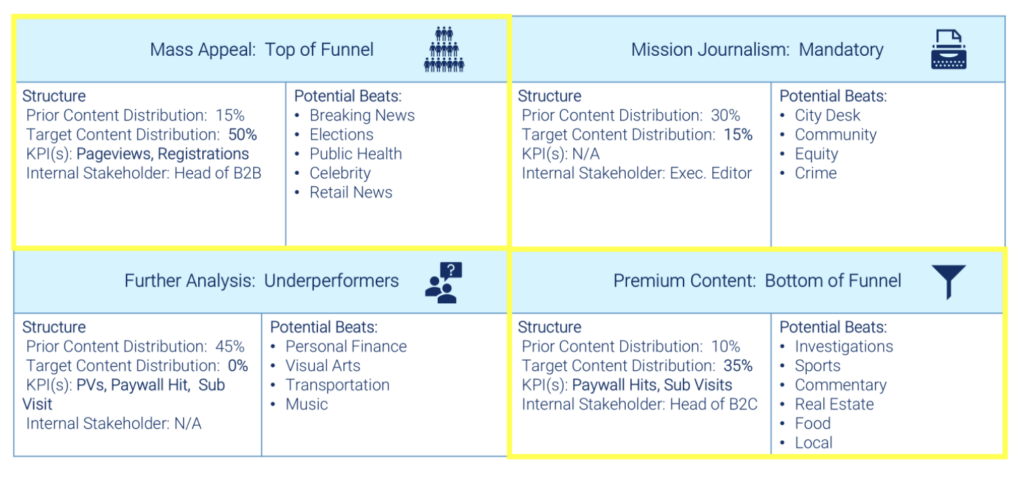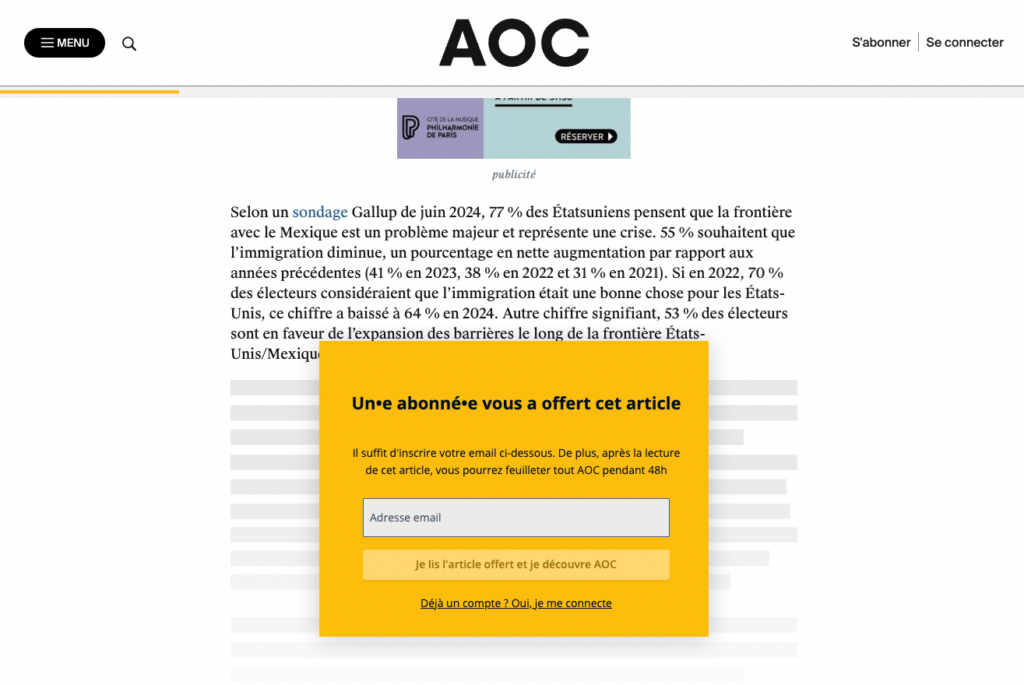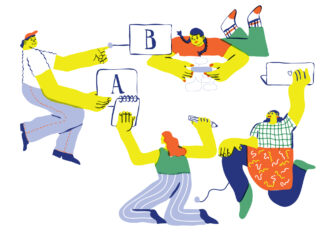

In partnership with Atlas, the recurring revenues growth consultancy, The Audiencers recently ran a survey to find out how media companies with a paywall model decide which articles to block and which to leave open to all audiences. The findings revealed that the majority of publishers base this decision on the content alone – often its reach and conversion potential. Is this the best approach, or can new technology and customer insights help to optimize this key decision?
However, instead of considering which articles to block, which paywall model to employ, what percentage of articles should be blocked, etc., the advice given throughout this article is that publishers should be considering how to maximize the value of each individual reader, building dynamic models to adapt to more than just the content type.
How do you currently decide which article is free or premium?
The overarching trend is that a decision to block an article with a paywall or not is based on the article itself, generally the value-level:
- Short articles are “free” – e.g. breaking news and service news
- In-depth features are “premium” – e.g. Columnists, in-depth analysis
Mather Economic’s matrix summarizes it quite neatly, sharing KPIs for these ‘content-types’, each of which has a different business goal. In particular, mass appeal content is for advertising, whilst premium content is for subscription revenue.

Ultimately, it’s about the reach and conversion potential of the article. Who makes this judgment – and based on what metrics- varies for different publisher respondents.
For example, one publisher in the survey shared that whilst the above is true, they also measure velocity and engagement within the first three hours of publishing, producing a list of potential premium articles. Editorial teams then make a decision on which articles to block with a paywall from this list, post-publication.
A few in the survey specified that this freemium model has been developed to better facilitate a balance between frustration and engagement. Specifically:
- Free articles are blocked by a registration wall, allowing readers access to a set quota of articles for free per month. This also allows for data collection and increased ad revenue through targeting
- Premium articles are open for the first article, and blocked on the second, allowing the reader to see the value of subscribing
Others go even deeper in their dynamicity, often applying the above, but with some dynamic additions based on the user:
- Churned subscribers are always hardwalled (blocked on all articles by a hard paywall) because of high propensity to subscribe
- Social referrals have a registration wall and free pageview because of low likelihood to subscribe
- The paywall journey can also depend on device-type
- All articles that are also featured in print are hardwalled
- Readers that are gifted an article by a subscriber are presented with a 48h discovery pass
AOC in France employ the strategy in this final bullet point, asking for the reader’s email address in exchange. Click-through rate on this wall is at 32%, well above market averages.

Another interesting criteria on when to unlock or lock articles is based on time-since-publishing. One publisher noted that they hardwall all articles for one week, unlocking them for standard metering after 7 days.
BILD case study
BILD in Germany also brought up the topic of article relevancy in a podcast, giving the example of an article covering the news of a player transferring teams. Whilst it’s still breaking news, this is valuable information for subscribers to be able to access before other readers, so at this time it’s premium.
Then, as Daniel Mussinghoff, Premium Director at BILDplus shared, “at some point it just doesn’t make sense to leave this article behind a paywall as it’s all over other news portals too. But then we also know that we can follow up relatively quickly and try to get more information. In other words, the first photos of the medical check, the first interview, the first details about the contract, how much he’ll be earning, the transfer fee, what the agent is getting… We’re of course interested in being able to follow up and also follow up with more plus articles.”
> To read next: How to evaluate the success of your subscription model (before optimizing)
Going beyond a decision made on content type alone
For the most part, respondents’ focus was on using the content type (as detailed above) to define whether the reader would be blocked by a paywall or not. However, this proves to be limited in its value for publishers given the wide variety of reader profiles visiting a publisher’s site. In particular, with different reader profiles comes different levels of engagement, so a blanket approach is rarely going to apply for all of them.
DRIVE research reveals that 95% of users fall into the ‘unengaged’ category, with less than 120 seconds active on the website per month.
As a result, the best solution does appear to be taking the ‘freemium’ base, and adding on layers of dynamicity based on the user’s level of engagement.
In this model, you have 4 contexts to build a conversion journey for:
- Less engaged, on a ‘free article’ -> goal of engaging, maybe through a newsletter wall or leaving the article open
- Highly engaged, on a ‘free article’ -> goal of frustrating slightly and increasing value, maybe through registration
- Less engaged, on a ‘premium article’ -> goal of showing the value of subscribing
- Highly engaged, on a ‘premium article’ -> goal of converting to subscription
You can then develop this model by adding more layers of dynamicity to adapt to more than just level of engagement, such as:
- Device type
- Content tags (e.g. topic, author, etc.)
- Reader location
- User status (e.g. ex-subscriber, registered member, event attendee)
- Source of traffic (e.g. social media, newsletter)
In order to tailor your conversion approach to maximise engagement, you need real insights into why your readers are on your site, what content they value and their needs as customers, A “one size fits all” approach assumes every reader wants the same thing, whereas a dynamic approach driven by audience knowledge allows you to provide bespoke, engaging and authentic experiences. Atlas are seeing personalization driving results across publishers of all sizes, supporting the idea that customer-centric thinking is more likely to achieve your goals.
Abi Spooner, Strategy Partner, Atlas
Back to the survey…
Is this decision manual or automated?
The majority of respondents chose manual, making the decision based on their overall business model – advertiser value from all customers versus higher value from paid or registered subscribers.
The decision of whether the article will be free or premium is usually made before the article has even been written, but this is situation dependent. For instance, some publishers note that article performance is tracked post-publication and that teams might decide to add a paywall to a free article if it has particularly high traffic with the goal of maximizing its value for conversions.
But some note that it’s rare that the reverse change is made: i.e. that they remove the paywall to make it free to read.
For another, they barely ever change their mind post-publication for SEO reasons.
We were curious on what these SEO reasons may involve, so we turned to the WTF is SEO? Team who shared that it “depends on how Google sees it. Nowadays, since everything has a paywall it tends to say ok as long as this still meets intent, but if there’s an unlocked version of the same intent it may favor that or knock the story after the bounce rate increases from people hitting the wall. We’ve seen it both ways and experimented with it with little effect though so I wouldn’t be too worried.”
“The decision is automated”
For those who shared that the decision is automated, it’s based on predefined metrics like author name, section, etc.
One publisher in South America mentioned an engagement scoring system that we’d never encountered before:
UVS (User Value Score) – a number between 1 and 100 that determines how much content a user gets access to. 0 is fully premium, 100 is free.
UVS is determined by frequency of visits and how many articles a non-subscriber user reads a month. The more they read, the less content they will have for free (paywalled articles).
But another publisher who shared that the decision is automated highlighted that top editors can choose to exempt articles with limits.
The case of Business Insider
In a recent Digiday article, Business Insider announced their move to an automated ‘smart’ paywall model:
Instead of the manual free vs premium split, the new smart paywall instead determines the content that individual users are most likely to pay to access based on their previous reading habits, which platform they come to the website from and the propensity that each genre of content has for converting readers. Using those insights and Google Analytics data, the AI’s algorithm decides whether users meet a paywall, registration wall or nothing upon entering the website.
By the end of the testing period, which spanned December to April, the team said that 60% of new conversions happened on “non-premium” stories, meaning stories that never would have been paywalled in the previous model.
This is a big challenge to all of those publishers who are making manual decisions – is it the right strategy to follow?
Ultimately, manual-only decision-making tends to be the first step in a journey towards highly dynamic, machine-learnt models. It is, however, an important step that allows teams to understand the processes behind automating, better train and inform editorial teams on what successful articles (for conversion and advertising) look like and ensure machines are being used effectively.
If you’re thinking about automating your decision-making, perhaps consider these key questions from Lars K. Jensen – they were written about automating tagging for user needs, but fit equally well in this context:
- What are you trying to automate?
- Why do you want to automate that?
- What are the scenarios – what do we risk losing in terms of skills and knowledge?
- How will the machine decide or suggest? How is the algorithm built?
- What data is it trained on?
- Can it be trained on our content and data?
- What is the definition of success in this particular automation and/or implementation?
What percentage of your content is currently behind a paywall?
Respondents to this survey shared a range from 10-99%, but average is 60-70%.
Importantly, however, a key metric to measure is the percentage of traffic visiting premium content. Because, of course (and particularly in the interest of doing more with less) there’s no point producing a huge amount of premium content if no one visits it. As a benchmark, Poool data reveals an average of 68% of total traffic on premium (compared to free) content for Q2 2024.
Do you block with any other types of walls?
Cookie walls are mentioned by Europeans, where tightening regulations on cookie consent are leading to falling consent rates. This type of wall is shown to readers who decline cookies on the CMP banner – they’ll be asked to either change their mind (i.e. accept cookies) or support the media in another way, such as by paying to subscribe. Importantly though, in countries such as Germany and France, the alternative option must only involve data collection that’s considered ‘essential’ in order to be legal (see France’s online data privacy regulation board, the CNIL’s response to Cookie Walls) .
Publishers in France and Germany have been employing this strategy for a few years now, and the UK has recently followed, leading to increasingly more cookie walls being used across the continent.
> Cookie wall benchmarks and best practices to increase consented page views
But registration walls were the most common in this survey – typically being displayed after 1-3 articles allowing the reader access to another 2-3 more articles.
An interesting precision by one: registration walls are used for commenting on articles and account creation is required to read articles gifted by subscribers.
Tests to inform the ‘free vs premium’ decision
- Tests on registration walls and the number of free articles.
“We used a hard reg wall (first page view of all content) for a 6 month trial- while we saw an expected increase in registrations, we saw a severe decrease in traffic, engaged time and returning visitors. We moved to a second page view reg wall to capture people who are more engaged than flyby visitors.”
Nikkei Asia ran similar tests, finding that just a single article for free, compared to 10, was optimal for conversion rate to subscription. More on their experiment here.
- Tests on which content to block.
“We have analyses on which topics, authors, and themes fall into the average audience quadrant that most commonly convert subscriptions. Some subjects always convert. These were recommended to be published with a hard paywall.”
Another notes that they often test blocking/unblocking a journalist’s work or certain topic area to see which is more valuable for that context.
- Tests to find out the average page views per topic, and per reader-type to be able to develop dynamic models.
- Tests on conversion “assists”, i.e. the last article read before a conversion
How do you measure the success of your premium articles?
- Last-click conversion and assists (ie articles read in the run-up to a conversion)
- First click conversion (working on last click), subscriber page views, time on page
- Last click conversion and engagement
- Premium content visibility rate
- Subscriber engagement
- Paywall stop rate
- Media Time
Atlas’ 5 top tips for paywall success
- Measuring success varies across publishers, but most are focused on engagement by topic or subject. There’s a clear desire for analysis to understand what role an article plays both in direct conversions and assisting conversions overall. Engagement measurements are – out of necessity – bespoke to brands and their content, but the overall approach does seem to be aligned. What is the key engagement metric for your brand?
- Understand your audience and what they value. Identify those who are more likely to engage in the long term and focus on them.
- Tech facilitates personalization – understand your use cases and implement wisely and methodically.
- Understand what success looks like to your bramd and define what KPIs will help you assess performance, both immediately and over customer lifetimes
- Consider context, especially for high-impact or sensitive events. Align decisions with the brand mission and customer expectations. Be sensitive
- Test, test, test – don’t just set rules and leave them.












